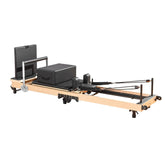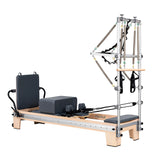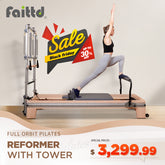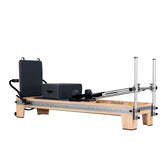Advanced Pilates Reformer: Expert Tips for Building Muscle and Strength
Ever wonder how advanced Pilates Reformers can change your body? You are not just working out with reformer Pilates; you are into a whole-body experience that will build strength and tone muscle in a way you have never experienced. Advanced exercises, with controlled movements and spring-loaded resistance, target many different muscle groups at one time. What's more, the low-impact nature of reformer Pilates makes it a perfect fit to boost your endurance while being gentle to your joints. It's a game-changer in regard to physical performance and fitness overall.
Key Takeaways
- The advanced level of Pilates exercises trains the body in gaining strength and toning muscles.
- It employs springs and controlled movements to address a number of muscles.
- More frequent practice provides better flexibility for everyday movements and minimizes injury sustained during various forms of activity.
- Emphasizing core strength and balance will improve both workouts and lifestyles.
- A good warm-up and well-rounded schedule provide superior results.
- Learning from an educated instructor helps to keep one safe while developing skills.
3 Unique Benefits of Advanced Pilates Reformer Workouts
Muscle Strengthening
Advanced Pilates reformer workouts are a powerhouse for building strength and definition. These exercises use spring-loaded resistance to challenge multiple muscle groups at once. Unlike traditional weightlifting, reformer Pilates focuses on dynamic movements that engage your entire body. This means you’re not just isolating one area—you’re working everything from your core to your legs and arms.
Take a look at how advanced pilates targets specific muscle groups:
| Muscle Group | Description |
| Core muscles | Engages abdominal muscles, obliques, and lower back. |
| Glutes | Targeted through exercises like Bridging and Leg Press. |
| Legs | Includes quads, hamstrings, and calves. |
| Back and shoulders | Engaged through various Pilates equipment workouts on the reformer. |
By consistently practicing advanced Pilates reformer workouts, you’ll notice stronger core muscles, toned legs, and improved upper body strength. Plus, the constant tension from the reformer springs keeps your muscles activated throughout each movement, boosting both strength and endurance.
Flexibility and Mobility
Advanced Pilates reformer exercises help one achieve flexibility and mobility. While working out, it does not simply stretch one's muscles but rather lengthens and strengthens them simultaneously. With practice over time, one's range of motion is improved and overall stiffness reduced to allow ease in day-to-day movements.
- Reformer Pilates improves posture by strengthening core muscles and increasing spinal mobility.
- Enhanced flexibility lowers the risk of muscle strains and joint injuries, which is a game-changer for athletic performance.
With advanced Pilates, you will strike a perfect balance between strength and flexibility. Whether you are an athlete or someone who desires freedom of movement, these exercises will take you to a body that feels strong yet supple.
Core Stability and Balance
One of the standout benefits of advanced Pilates reformer workouts is how they enhance stability and balance. These exercises target deep stabilizing muscles in your abdomen and back, which are essential for maintaining proper alignment and preventing injuries.
Advanced Pilates reformer workouts also incorporate challenging movements that test your coordination. For example, exercises like Side Splits or Tendon Stretch require full body engagement and precise control. Over time, you’ll notice improved balance, better posture, and a stronger connection between your mind and body.
From sports to something as casual as being able to walk with confidence, stability-focused workouts help you be ready for it all. It is all about strength and endurance, developed in a manner that will contribute to overall performance.

Key Advanced Pilates Reformer Exercises
1. Footwork on the Reformer
Footwork on the reformer is one of the major exercises that helps your lower body get strong and aligned. This dynamic reformer exercise will hit several key muscle groups, including quadriceps, hamstrings, glutes, and calves. You can adjust the spring resistance according to your fitness level by increasing or decreasing it. Here is why this exercise shall not be missed: It strengthens the muscles in your lower body. It improves flexibility in your legs.
Here’s why this exercise is a must:
- It tones your lower body muscles.
- It enhances flexibility in your legs.
- It promotes better alignment, which is crucial for posture.
To do this, lie on the reformer with the feet on the foot bar. Push the carriage away with controlled movements, then return to the starting position. This exercise is simple but effective to give one strength and gradually get the body ready for higher-level techniques.
2. Long Box Series
Long Box Series is an all-inclusive class of advanced Pilates reformer exercises focusing on the upper body and core. Performed with a long box placed on the carriage, this will add some great variety and challenge to your routine.
Pulling Straps
Pulling straps is a great exercise for the upper back and shoulders. Lying on your stomach on the long box, grasp the straps in your hands. Pull the straps back, pinching your shoulder blades and engaging your core. This exercise builds not only muscle but also strengthens shoulder stability and improves posture.
Back Rowing
Another treasure in the Long Box Series is the Back Rowing. This will provide an engagement for your arms, shoulders, and upper back while your core will work for stability. Sit on the long box facing the footbar, and grasp the straps. Control a row backward, pulling into the chest area, while focusing on precision and form for fluid motion. This exercise improves the strength and coordination of the upper body.
3. Short Box Series
The short box series is all about core strength, flexibility, and balance. It incorporates a variety of spinal movements, making it a comprehensive workout for your midsection.
Tendon Stretch
Tendon Stretch is an advanced exercise that challenges your core and hamstrings. Stand on the reformer carriage with your hands on the foot bar. As you push the carriage away, engage your core to maintain balance. This movement improves flexibility and strengthens stabilizing muscles.
Side Splits
Side Splits is a dynamic reformer exercise that works your inner thighs, glutes, and core. Stand on the reformer with one foot on the carriage and the other on the platform. Slowly slide the carriage out and back in, focusing on control. This exercise enhances balance, flexibility, and lower body strength.
These advanced Pilates reformer exercises not only target multiple muscle groups but also improve your overall functional strength. By incorporating these into your routine, you’ll experience a full-body transformation that’s both challenging and rewarding.

Tips for Incorporating Advanced Pilates Reformer Exercises into Your Routine
Tip 1. Starting with a Proper Warm-Up
First of all, before starting with advanced Pilates on the reformer, one has to warm up the body in preparation for all that is coming. Start with light stretches to loosen your muscles and joints. Give special attention to areas like hamstrings, shoulders, and spine, since these are highly involved during reformer Pilates. Other dynamic movements may include cat-cow stretches or arm circles to help increase blood flow and flexibility.
Warming up prevents injuries, but it also prepares your body for better performance. It prepares your muscles for controlled movements that advanced Pilates requires. Moreover, it helps you get into your breath, which is an important component in Pilates exercises. Take a few minutes to warm up before doing Pilates; it's worth it.
Tip 2. Creating a Balanced Workout Schedule
The secret to strength, endurance, and overall fitness is a well-rounded Pilates routine. Consistency is, therefore, indispensable for the best results expected from advanced Pilates reformer exercises. Aim for 3-4 sessions per week to see steady progress.
Here’s how to design a balanced schedule:
- Practice Consistently: Stick to a regular schedule to build momentum.
- Work on Compound Movements: Include exercises like side splits or the star to engage multiple muscle groups.
- Incorporate Plyometric Movements: Add dynamic exercises to boost intensity and cardiovascular fitness.
- Challenge Balance and Stability: Try advanced moves like the snake and twist to test your coordination.
By targeting different muscle groups—core, glutes, legs, back, and shoulders—you’ll develop balanced strength and correct any muscular imbalances. The method is also good for enhancing posture, improving flexibility, and increasing the range of motion. Advanced Pilates reformers make adjustments of resistance very easy; hence, you are in a position to tailor each session to suit your needs.
Tip 3. Tracking Progress and Setting Goals
Tracking your progress keeps you motivated and accurate to continue with the workouts. Find what works for you: a notebook, an app, or even a spreadsheet; write down such details as which exercises you've done, how much spring resistance you used, and how you felt after performing them.
Setting realistic goals is just as important. Start small, like mastering a specific exercise or increasing resistance gradually. Celebrate milestones to stay inspired. If you’re using a reformer like the Frame Fitness model, it can even track your achievements automatically, making it easier to monitor your growth.
Tip 4. Working with a Certified Instructor
When it comes to advanced Pilates reformer exercises, working with a certified instructor can make all the difference. These professionals bring expertise and guidance that help you get the most out of your workouts while staying safe. Advanced Pilates requires precision and control of movement, plus correct alignment—all things an instructor will guide you through.
Certified instructors undergo extensive training to perfect their craft. They complete over 200 hours of coursework, personal practice, and teaching experience. This will involve mastering movement principles, anatomy, and advanced reformer techniques among others. They also pass rigorous written and practical exams to get certified. With this level of expertise, they can tailor exercises for your fitness level and goals while you progress safely and effectively.
Besides that, an instructor would help you avoid mistakes that hold you back from achieving your results or even create injuries. Examples of such include rushing exercises or using incorrect alignment, which strains muscles. A certified instructor will remind one to slow down and focus on control and good posture.
If you are committed to advancing further in Pilates, investment in sessions by a certified instructor is well warranted. They can help you get the most effective results in a safe and confident manner regarding your fitness goals.

Get Stronger with Advanced Pilates Reformer
Advanced Pilates Reformer workouts might be just what you're looking for. These aren't your average gym sessions. You'll use a special machine that helps you move in ways you never thought possible.
Stick with it, and here's what you'll notice:
- Your whole body gets stronger, especially your core
- You'll stand taller and feel more balanced
- Those annoying aches and pains? They might just disappear
- You'll have more energy throughout your day
But here's the cool part—it's not just about getting stronger. You'll feel more confident too. Each time you nail a tough move, you'll prove to yourself what you can do. And that feeling? It carries over into everything else in your life.
Sure, some moves might seem tricky at first. But don't worry! Start with the basics and build up slowly. Focus on doing each move right, not fast. Keep showing up for your workouts, and you'll be amazed at how quickly your body adapts.





